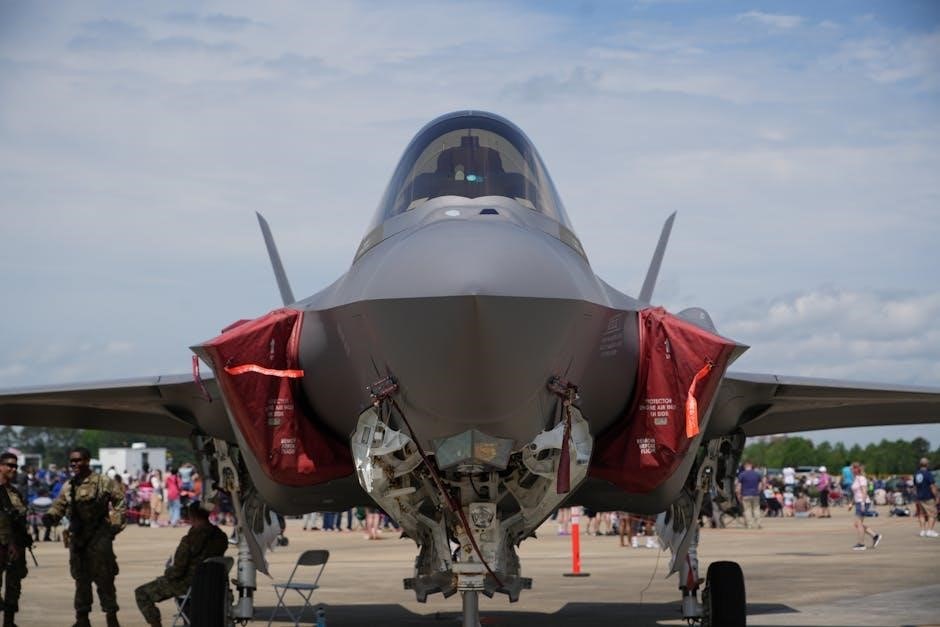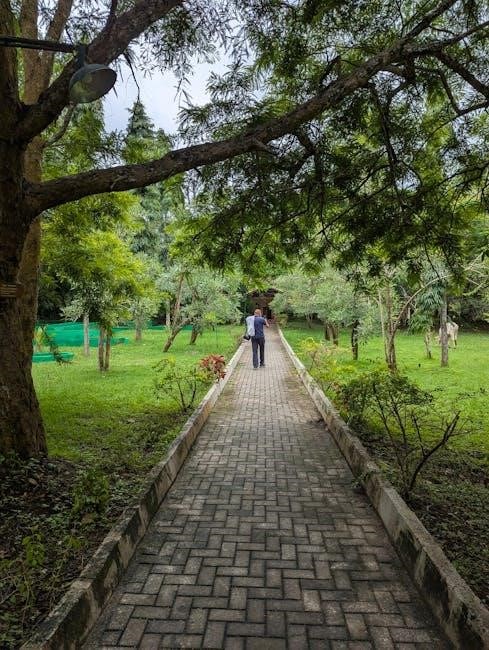Discover essential guidance for assembling and maintaining your canopy. Learn step-by-step instructions for installation, fabric fitting, and long-term care to ensure durability and safety.
1.1 Understanding the Importance of Canopy Instructions
Canopy instructions are crucial for ensuring safe and proper installation, longevity, and functionality of your gazebo or canopy structure. Proper assembly prevents structural issues and ensures stability, especially in harsh weather conditions. Clear instructions guide users through fitting the fabric correctly, securing edges, and aligning frames, which are essential for maintaining the integrity of the canopy. They also provide tips for regular maintenance, such as cleaning and inspecting for damage, which extends the lifespan of the fabric and frame. Additionally, instructions often include warranty details and safety precautions, helping users understand their responsibilities and protect their investment. By following these guidelines, you can enjoy your canopy for years while ensuring safety and optimal performance. This guide will walk you through every step, from preparation to maintenance, to maximize your outdoor experience.
1.2 Purpose and Scope of the Guide
This guide provides a comprehensive overview of canopy installation, maintenance, and troubleshooting; Its purpose is to assist users in safely and effectively assembling, maintaining, and repairing their canopies. The scope includes detailed step-by-step instructions for frame assembly, fabric installation, and securing edges. It also covers essential maintenance practices, such as cleaning, inspecting for damage, and seasonal storage. Additionally, the guide addresses common issues like fabric tears and frame misalignment, offering practical solutions. By following this guide, users can ensure their canopy remains durable, functional, and visually appealing. The content is designed for homeowners, DIY enthusiasts, and professionals, offering clear, actionable advice to maximize the lifespan and performance of your canopy. Whether you’re setting up a new gazebo or repairing an existing one, this guide serves as an indispensable resource.

Preparation for Canopy Installation
Ensure a smooth installation by selecting the right canopy, preparing the site, and gathering essential tools and materials. Proper planning ensures safety and efficiency during setup.
2.1 Choosing the Right Canopy for Your Needs
Selecting the appropriate canopy is crucial for functionality and durability. Consider factors like size, material, and design to match your space and intended use. Measure the area where the canopy will be installed to ensure proper fit. Decide between temporary or permanent structures based on your needs. Check the material’s durability, water resistance, and UV protection. Choose colors and styles that align with your surroundings for aesthetic appeal. Consider seasonal usage and whether the canopy can withstand local weather conditions. Ensure the canopy complies with local building codes or regulations. Assess the weight and portability if you plan to move it frequently. Finally, compare brands and reviews to find a reliable product within your budget. Careful selection ensures long-term satisfaction and functionality.
2.2 Essential Tools and Materials Required
Assembling a canopy requires specific tools and materials to ensure a smooth installation process. Start with basic tools like screwdrivers, wrenches, and hammers. A measuring tape is essential for accurate adjustments. Pliers and Allen keys may also be necessary for securing bolts and connectors. Ensure you have a ladder or step stool for reaching higher areas. For cutting or trimming, a utility knife or scissors will be useful. Safety gear like gloves and safety glasses should always be worn. Check the canopy kit for included hardware, such as bolts, screws, and brackets. Additional materials like anchors or weights may be needed for stability, depending on the setup. Weatherproofing items like sealant or tape can help protect the structure. Make sure all tools and materials are within reach before starting the assembly to avoid delays.

2.3 Site Selection and Preparation Tips

Selecting the right location for your canopy is crucial for stability and functionality. Choose a flat, even surface to ensure proper installation and prevent uneven weight distribution. Avoid areas with standing water or poor drainage to minimize the risk of water pooling under the canopy. Check for underground utilities and ensure the site complies with local regulations. Clear the area of debris, rocks, and vegetation to create a smooth working space. Measure the space to confirm it can accommodate the canopy’s dimensions. Use a chalk line to mark the perimeter where the canopy will be installed. Ensure the ground is firm and level; if not, use shims or adjust the legs to stabilize the structure. Remove any obstacles that could interfere with the installation or use of the canopy. Finally, inspect the surrounding area for overhead obstructions like power lines or branches.
Step-by-Step Assembly Instructions
Begin by unpacking and organizing all components. Follow the manufacturer’s sequence for assembling the frame, ensuring all bolts and connectors are securely tightened. Use the provided tools to avoid damaging parts. Align the frame sections precisely and double-check each connection for stability. Refer to the instruction manual for specific assembly diagrams and instructions tailored to your canopy model.

3.1 Assembling the Canopy Frame
Start by organizing all frame components on a flat, stable surface. Attach the legs to the base plate using the provided bolts and washers. Next, connect the side poles to the top frame, ensuring all clips and connectors are secure. Use a wrench to tighten all bolts firmly, avoiding over-tightening to prevent damage. Double-check the alignment and stability of the frame before proceeding. Ensure all joints are properly locked and the structure stands upright without wobbling. Refer to the instruction manual for specific diagrams or additional guidance if needed. Proper assembly of the frame is crucial for the canopy’s stability and safety. Take your time to ensure every connection is secure and aligned correctly.
3.2 Attaching Roof and Support Components
Once the frame is assembled, carefully place the roof panel onto the top of the frame, ensuring it is centered and evenly aligned with the connectors. Secure the roof by attaching the hooks or straps to the frame’s connectors. Tighten the straps or ropes firmly to ensure the roof is taut and evenly spread. Next, install any additional support components, such as cross beams or stabilizing poles, to enhance the structure’s stability. Use the provided hardware to fasten these components securely. Double-check that all connections are tight and the roof is properly aligned. For added stability, ensure all edges and corners are evenly tensioned. Finally, inspect the entire assembly to confirm the roof is securely attached and the frame remains stable. Proper attachment ensures safety and prevents damage from wind or weight.

Canopy Fabric Installation
Installing the canopy fabric involves fitting it over the frame, ensuring a snug and even spread. Secure the edges tightly to achieve a durable and weather-resistant fit.
4.1 Fitting the Canopy Fabric Properly
Fitting the canopy fabric requires precision to ensure a seamless and durable installation. Begin by aligning the fabric with the frame, starting from the center and working outward. Use the provided hardware, such as hooks or straps, to secure the fabric to the frame. Make sure the fabric is evenly stretched to avoid wrinkles or sagging. Tighten the material gradually, checking each corner for proper alignment. For larger canopies, consider enlisting assistance to handle the fabric efficiently. Ensure the fabric lies flat and smooth, with no excessive tension that could cause tears. Proper fitting ensures the canopy remains stable and visually appealing. Always refer to the manufacturer’s guidelines for specific fabric attachment methods. This step is crucial for both functionality and longevity of the canopy.
4.2 Securing the Canopy Edges and Corners
Securing the canopy edges and corners is essential for ensuring stability and preventing damage. Start by attaching the fabric edges to the frame using Velcro straps, elastic cords, or screw-in eyelets, depending on the canopy design. Tighten these securely but avoid over-tightening, as this may cause the fabric to tear. For corners, use reinforced ties or brackets to maintain a snug fit. Apply weatherproof adhesive strips or seam sealant to prevent water seepage. Ensure all fasteners are tightly secured and evenly spaced to distribute tension evenly. Regularly inspect the edges and corners for signs of wear or loosening. Addressing these issues promptly will extend the canopy’s lifespan and maintain its structural integrity. Properly secured edges and corners ensure the canopy remains stable in various weather conditions.

Maintenance and Care
Regular maintenance ensures longevity and functionality. Inspect the canopy frequently, clean it properly, and address any damage promptly. Store it seasonally to protect against harsh weather.
5.1 Cleaning and Preserving the Canopy Fabric
Begin by gently sweeping or brushing off loose debris to prevent scratching. Use mild soap and warm water to clean the fabric, avoiding harsh chemicals or abrasive scrubbers. For stains, apply a fabric-safe stain remover and rinse thoroughly with clean water. Allow the fabric to air dry completely to prevent mold or mildew. Regular cleaning helps maintain water resistance and extends the fabric’s lifespan. To preserve the canopy, consider applying a waterproofing spray after cleaning, ensuring it’s compatible with the fabric type. Always follow the manufacturer’s guidelines for specific care instructions. Proper storage in a cool, dry place during off-seasons further protects the canopy from damage and fading.
5.2 Regular Inspections for Damage
Regular inspections are vital to ensure the canopy remains in good condition and functions properly. Start by visually examining the fabric for tears, holes, or fraying, especially around seams and corners. Check the frame for signs of rust, bending, or loose connections. Inspect the roof supports and edges for wear or sagging. Look for evidence of weather-related damage, such as UV fading or water pooling areas. Test the stability of the structure by gently tugging on the frame and fabric. Address any issues promptly to prevent minor problems from escalating. For canvas canopies, ensure stitching is intact and tighten any loose threads. For metal or PVC frames, apply rust-inhibiting treatments if necessary. Regular checks help maintain durability and ensure safety. Schedule inspections after severe weather or at least twice a year for optimal maintenance.

5.3 Seasonal Storage and Protection
Proper seasonal storage and protection are crucial for extending the lifespan of your canopy. Before storing, ensure the canopy is completely dry and free from dirt or debris. Disassemble the frame and fabric according to the manufacturer’s instructions to prevent damage during storage. Use protective coverings or bags to shield components from dust and moisture. Store the canopy in a cool, dry place away from direct sunlight and extreme temperatures. Avoid folding or creasing the fabric to prevent permanent damage. For metal frames, apply a rust-inhibiting coating before storage. Label and organize parts for easy reassembly. If storing for extended periods, check on the canopy periodically to ensure no pests or mold have developed. Proper storage ensures your canopy remains in excellent condition for future use.
Troubleshooting Common Issues

Identify and resolve common canopy issues promptly to ensure stability and longevity. Address leaks, uneven frames, or loose connections for optimal performance and safety.
6.1 Addressing Fabric Tears and Damage
When dealing with fabric tears or damage on your canopy, it’s crucial to act quickly to prevent further deterioration. Start by assessing the size and location of the tear. For small damages, apply a patch kit specifically designed for your canopy’s fabric type, ensuring proper adhesion. Larger tears may require sewing with waterproof thread or even professional repair. Always clean and dry the area before making any repairs to ensure effectiveness. Regular inspections after storms or high winds can help identify issues early. Additionally, consider preventive measures like trimming nearby branches and securing the canopy during harsh weather to minimize future damage. Proper maintenance will extend the lifespan of your canopy and maintain its functionality.
6.2 Adjusting and Aligning the Frame
Properly adjusting and aligning the canopy frame is essential for stability and functionality. Begin by ensuring all bolts and screws are tightly secured, as loose connections can lead to misalignment. Use a spirit level to verify the frame is perfectly horizontal and vertical. If the frame is uneven, adjust the legs or base plates accordingly. For metal frames, check the connectors and hinges for alignment, tightening any loose parts. If the frame is slightly bent, gently manipulate it back into shape, but avoid excessive force to prevent breakage. Regularly inspect the frame for signs of wear or shifting, especially after storms or heavy use. Adjustments should be made incrementally, testing the frame’s stability after each change to ensure optimal alignment and structural integrity.
Safety Precautions
Ensure secure anchoring, use proper tools, avoid overloading, and inspect regularly. Keep clear of power lines and follow manufacturer guidelines for safe assembly and usage.
7.1 Weather-Related Safety Considerations
Always assess weather conditions before assembling or using your canopy. Avoid installation during strong winds, as it may destabilize the structure. Secure the canopy firmly to prevent damage or displacement. Heavy rain can cause water pooling on the fabric, so ensure proper drainage to avoid sagging or collapse. Snow accumulation should be removed promptly, as excess weight can compromise the frame’s integrity. Additionally, avoid using the canopy in extreme temperatures or prolonged sunlight, as this may degrade the fabric over time. Regularly inspect the canopy after severe weather for signs of damage or wear. Never ignore weather-related risks, as they can lead to structural failure or safety hazards. Always follow manufacturer guidelines for weather-specific care and maintenance.
7.2 General Usage and Assembly Safety Tips
Ensure all safety precautions are followed during canopy assembly and use. Always wear protective gear, such as gloves and safety glasses, to prevent injury. Make sure the area is clear of obstacles and tripping hazards. Avoid over-tightening bolts or screws, as this may damage the frame. Use only the tools and materials specified in the instructions to maintain structural integrity. Never assemble or disassemble the canopy while standing on an unstable surface or ladder. Ensure the canopy is securely anchored to the ground or base to prevent shifting. Be cautious of sharp edges or points on metal components. If unsure about any step, consult the manual or seek professional assistance. Regularly inspect all components for wear or damage before use. Always follow load capacity guidelines to avoid overloading the canopy. Keep children and pets away during assembly and disassembly. Properly store tools and materials after use to prevent accidents;

Manufacturer Warranty and Service Life
Understand the manufacturer’s warranty period and service life expectations for your canopy. Regular maintenance ensures longevity. Check the manual for specific warranty terms and conditions.
8.1 Understanding the Warranty Period
Understanding the warranty period for your canopy is crucial to ensure protection and peace of mind. Most manufacturers offer a warranty that covers defects in materials and workmanship for a specified duration. Typically, this ranges from 1 to 5 years, depending on the product quality and brand. It’s essential to review the warranty terms provided in the manual or product documentation. Coverage may vary, with some warranties extending to structural integrity while others focus on fabric durability. Always check for conditions that may void the warranty, such as improper installation or neglect. Registering your product with the manufacturer can often enhance or extend warranty benefits. Regular maintenance, as outlined in the guide, helps ensure warranty claims are honored. Keep records of purchases and maintenance for verification purposes.